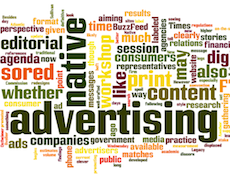I am wondering these days whether native advertising is truly a breakthrough format and has financial legs to underwrite a volume of quality digital journalism. But the Federal Trade Commission has a narrower focus for its one-day workshop in Washington Wednesday: are consumers being confused and potentially misled?
This is a staff-led information gathering session. FTC commissioners may attend but most likely will not. There will be no on-the-spot action or even findings.
“Native advertising” is a paid placement that matches the editorial and design style of a given website. “Sponsored content” is a synonym, though other labels like “promoted by” may be used. This is the digital descendant of the print advertorial, though some contend the potential for confusion is greater.
The FTC’s announcements have said it would be premature to expect that regulations are coming. But you don’t have to have a deeply Machiavellian turn of mind to discern a hidden agenda. By scrutinizing native advertising, the government is inviting those producing and publishing in the hot new format to self-regulate — to clearly label sponsored messages in story form.
Those speaking will include representatives of the American Society of Magazine Editors, which has been trying to rein in poorly labeled print advertorials for decades, and of the Interactive Advertising Bureau, which seeks to promote and simultaneously improve digital advertising and its measurement.
At a similar FTC workshop on the future of news four years ago, I spoke at the opening session about the deep declines in newspaper advertising and the resulting loss of at least $1.6 billion a year in news gathering effort. I offered a month ago to update that context and talked by phone with FTC attorneys Laura Sullivan and Michael Ostheimer, who were organizing the session.
But theirs is a consumer protection perspective not a broad inquiry into the capacity of media businesses. They were looking for research on how consumers encounter sponsored messages, especially in search results or from social media references, and whether consumers may be confused about whether they are seeing editorial content or something underwritten by an advertiser.
Those are fair questions. However, given the newness and evolving practice of native advertising and the measured pace of academic research, I would be surprised if definitive answers are available yet.
How we got to this set of issues is fairly straightforward. The boundaries between editorial and ads have been established by long experience in print newspapers and magazines. Even were the monthly supplement in the print New York Times on Russia not labeled advertising (as it clearly is), you would not mistake it for content produced by the Times news staff.
Basic website layout is a lot more fluid. Legacy organizations have only slowly realized that replicating the look of a print report is far from ideal and are now more experimental in redesigns. And what goes where in tablet and smart phone presentations is all the more undefined by convention.
At the same time, plain vanilla banner ads are mostly overlooked and keep falling in price thanks to the enormous inventory Facebook, Google, Twitter and others make available. So it is natural that advertisers are aiming to tell engaging stories to break through the clutter. Publishers want to satisfy that demand and get much higher prevailing rates.
(If the native ad boomlet also provides work for displaced writers, so much the better.)
Besides being much discussed, native advertising has developed some heft. EMarketer estimates that the category amounted to $1.6 billion in 2012 and will rise to $2.85 billion in 2014.
My own perspective is that the appeal of native ads is in an apt and well-crafted message that matches the spirit of the digital publication — be it hip like BuzzFeed or high-tone like the Atlantic Media’s Quartz. To put it another way, I don’t think aiming to confuse is the point. Good labeling is appropriate and ought not to spoil the effect.
A livelier question over time may be whether the rush to jump in the pool of sponsored content results in a glut — more clever little stories than people have time to read.
But that’s not the issue of the day for the FTC. The workshop lineup begins with former Columbia School of Journalism Dean Nicholas Lemann on the traditional wall between editorial and advertising. Also testifying will be representatives of digital-only sites like The Huffington Post, Mashable and BuzzFeed, which have lead the way on native advertising and legacy companies Hearst and The Wall Street Journal now following suit.
There will also be advertisers, their agencies and supporting tech companies on the agenda and several consumer groups skeptical about the practice.
Another participant is Steve Rubel of the Edelman public relations firm. He and the company have been promoting “an ethical framework” for sponsored content that opposes any blurring of the lines. The PR industry also has a financial stake in slowing the current trend — if native ad placements are handled by companies, agencies and buyers, public relations advisers could end up dealt out of their role of coordinating their clients’ messaging.
The workshop agenda shapes up more as a formula for airing out different views rather than reaching consensus, but I also think it is a mark of sponsored content’s fast progress and distinctiveness that it has grown to a point where it merits government scrutiny.








Comments